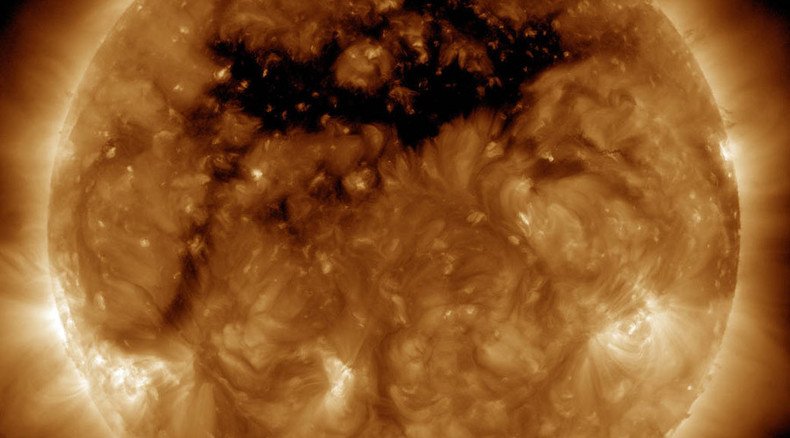As big as 50 Earths: NASA captures huge sun hole that produces high-speed solar wind

The idea is terrifying: A sun hole as big as 50 Earths which spews out a stream of high-speed solar wind, creating a geomagnetic storm close to our own planet. But as scary as it sounds, it looks just as cool, given a recent image released by NASA.
The dark spot, known as a coronal hole, which materialized last week remains harmless to humans on Earth but can interfere with satellite communications and some high-altitude radio signals.
The image was taken on October 10 in wavelengths of 193 Angstroms, NASA’s Solar Dynamics Observatory said. It is invisible to our eyes and typically colorized in bronze.
Dark area of the sun is a coronal hole where magnetic field is open to space: http://t.co/Sr7bTcEu9r@NASASunEarthpic.twitter.com/NQcjsK5ZgO
— NASA (@NASA) October 14, 2015Coronal holes appear randomly on the outer layer of the sun, making it look darker than the rest of the star. Caused by anomalies in the sun's magnetic field, the darker patch is abundant with colder, less dense, low-energy gas and plasma.
Sun Today, 14 Oct 2015, SDO/AIA reminds me of an image from SoHO in 2007, coronal hole called the elephant's trunk. pic.twitter.com/60JbrtfEwf
— Helen Mason (@helen_hm11) October 14, 2015These areas generate high-speed solar winds, as thinner portions of the magnetic field arch away from the corona, allowing solar winds to escape and head toward Earth. As the energy escapes at speeds of up to 500 miles (800 kilometers) per second, the surface leaves the hole dark.
20 looks in 20 yrs: Space photo collection shows sun’s dynamic makeovers http://t.co/FQOwkdtEiZpic.twitter.com/eH9Y6b67RK
— RT America (@RT_America) July 13, 2015This time the hole was measured to be 50 times as wide as the Earth and "created a geomagnetic storm near Earth that resulted in several nights of aurora," enhancing the northern lights, according to NASA.
On Earth the phenomenon created a G1-Minor storm which has lasted the past three days, according to the NOAA Space Weather Prediction Center. It is harmless to humans but could impact communication signals.
NASA's Solar Dynamics Observatory also captured a close-up of plasma loops, rolling off an active region of the sun, and traveling along the sun's magnetic field.
This particular region of activity appears as a sunspot to the naked eye, as its ultraviolet emissions give off little visible light. The SDO' video represents the two wavelengths, 193 angstroms and 304 angstroms.












